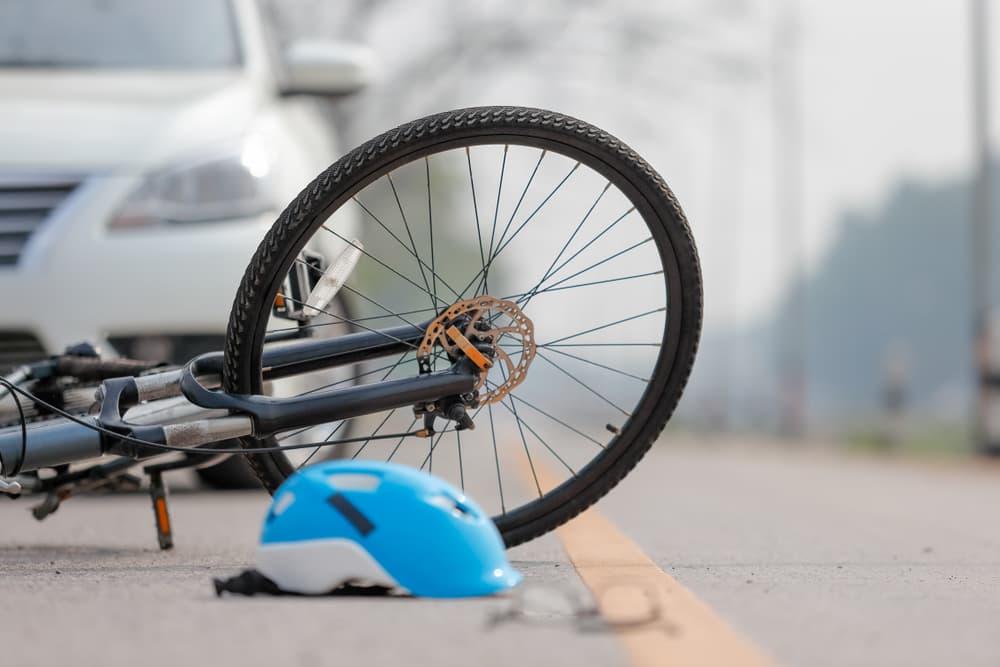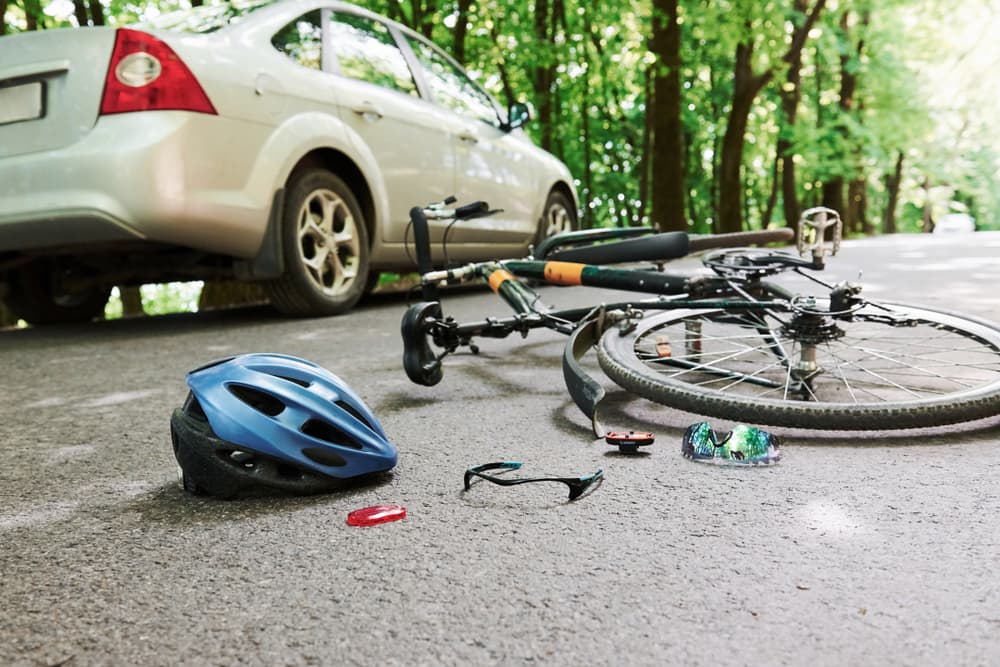Bicycling has been popular for hundreds of years in the United States, including in Illinois. Reach out to a Chicago bicycle accident lawyer. Today, children are not the only bicyclists that a driver of an automobile may see near a road.
Indeed, Illinois can be dangerous if you’re in a car or a bicycle. In the state, 26 bicyclists were killed in the last year for which statistics were available, and 2,663 were injured, according to the Illinois Department of Transportation. Car crashes were responsible for 700 deaths that year, and 93,517 injuries.
Collisions between the two can be especially dangerous. Bicyclists, even if helmeted, are relatively unprotected if they are struck by a car. They can be thrown immense distances or knocked off the bike into oncoming traffic.
Even a minor accident can result in broken bones and spinal or head injuries for the bicyclist. Car drivers tend not to register the presence of bicycles as much as they do cars, and can turn in front of them, sideswipe them, or even rear-end them.
In fact, a common bicycle accident is caused by car drivers opening their doors and getting out directly in the path of an oncoming bicycle. The bicyclist, in a “dooring” accident, can be thrown over the door or crash as a result of having to brake or swerve to avoid the door.
Car and bike accidents may be on the rise, especially in Chicago. Unfortunately, the climb stems in part from the Windy City’s success as a bike city. Chicago have created bicycle-only lanes of traffic, protected bike lanes, bike-sharing programs, as well as increased availability of bike parking and space for bikes on public transit.
We won tenth place in BikingExpert.com’s list of the top bike-friendly cities in America-and that’s on top of winning Bicycling magazine’s top honor for Best Bike City in America in 2016.
These awards stem from the number of bike paths and trails in the city-more than 200 miles worth, including the 20-mile trail on the side of Lake Michigan. And by next year, the city is estimated to have a whopping 600 miles of dedicated bike lanes.
The city has invested heavily in increasing bike paths and lanes over the three decades. People have responded. Many Illinois residents bike to work in Chicago and other cities, and many bike for leisure as well.
Despite these safety increases, bicycle accidents remain an extremely serious form of personal injury. The very nature of an unprotected cyclist vs a car leads to a situation in which the cyclists is almost surely going to suffer severe injuries or worse. And with more bike riding and ubiquity, especially on city streets, comes more potential for accidents causing fatalities and injuries.
Even a Chicago Sun-Times columnist wondered if great bike city awards were entirely accurate, given the city’s reputation for unsafe car drivers and roads under construction. Both can prove fatal to bicyclists.
Cycling is an eco-friendly, cost-efficient, and healthy alternative to driving a car. However, sharing the road with car drivers can be dangerous, which is why car versus bicycle accidents are so common in Illinois and other states.
If you or your loved one suffered injuries in a car vs. bicycle accident, consider contacting an experienced lawyer to help you pursue the compensation to which you are entitled.
What Should I Do if I’m in a Car-Bicycle Accident?
If you are in a car-bicycle accident, follow the same procedure as a car accident. If you are injured, call 911. They will alert emergency responders and police. The police will issue a police report, which can be used as evidence of what happened, who was injured, and what caused the accident.
If you are not injured seriously enough to need immediate medical attention, call the police. Exchange contact and insurance information with the other driver(s). Do not leave the scene of the accident unless you need to go to an emergency room via ambulance.
Take pictures of the accident scene with your smartphone, if you are carrying one. Pictures can be very helpful in determining the causes of the accident, via the trajectory of the vehicles, any skid marks, and other environmental markers.
If you don’t have a smartphone with you, take notes on what happened, what you remember, and similar facts.
It’s also a good idea to take pictures of your injuries, your bicycle or car, and any other personal or property damage. Be sure to get a copy of the police report. Police reports are evidence of what happened.
Even if you don’t believe you are seriously injured, see a doctor as soon as possible after the accident. A doctor can examine you to make sure you do not have serious injuries, and can treat any injuries you did sustain.
Determining Who Is at Fault for the Accident
Determining who is at fault for a car-bicycle accident is the same as determining fault in all accidents involving vehicles. The person or other entity whose actions (or failure to act appropriately) caused the accident to occur is usually considered at fault. In other words, even if the bicyclist is much more injured than occupants of the car, or the bicyclist is the sole person injured, the injuries have no bearing on the fault.
The law looks at behavior that was a causal factor in the crash.
Causal factors can include driving unsafely or not obeying traffic laws. If a car and a bicycle approach an intersection, for example, and the car is facing a yield sign, it should yield to the bicyclist. If it does not, the car’s driver will likely be considered at fault. Bicyclists have many of the same rights that cars do.
But conversely, a bicyclist riding outside of a designated bike lane may be considered partially at fault, because safe driving practices recommend staying in a designated lane. Please note that being partially at fault is not bar recovery for a bicyclist, but it could reduce the amount of damages awarded.
Factors other than a driver can also be at fault for an accident. Shoddy manufacture of either the car or the bicycle may result in defects that cause an accident. Manufacturers can be at fault in these accidents. Inadequately repaired or marked streets can cause an accident. The entity responsible for street maintenance can be at fault.
If you or a loved one are injured in a car-bike accident caused by another party, that party may be deemed liable. You can attempt to recover damages for your injuries from that party. There are two ways to recover damages: by going directly to the other party’s insurance company, or bringing a personal injury lawsuit.
What Damages Are Available in Car versus Bicycle Accidents?
When someone gets injured in a car vs. bicycle accident, they may be entitled to compensation from the at-fault party. A victim of a collision between a bicycle and motor vehicle can obtain compensation for their economic and non-economic damages.
Economic damages refer to any financial losses and monetary costs the victim has incurred after the accident, while non-economic damages are the emotional distress, suffering, pain, and other intangible losses.
Depending on the severity of your injury, you might recover damages for:
- Past and future medical bills
- Lost wages
- Diminished earning capacity
- The cost of repairing or replacing property
- Pain and suffering
- Post-traumatic stress disorder
- Diminished quality of life
- Loss of enjoyment of life
- Loss of companionship
- Disfigurement
- Permanent scarring
Illinois law also allows victims to recover punitive damages when they can prove that the defendant’s conduct can be described as outrageous, willful, or wanton (735 ILCS 5/2-1115.05).
If a victim of a bicycle accident died, their surviving family members might obtain compensation for funeral and burial expenses. Proving damages in the aftermath of a car vs. bicycle accident requires the injured party or surviving family members to gather evidence and documentation.
Calculating non-economic damages can be difficult because there are no receipts, bills, or invoices to prove intangible losses.
Do I Need a Lawyer if I’m Dealing With an Insurance Company?
While most people are familiar with the need to contact an attorney for a personal injury suit, it may be tempting to think you can make an insurance claim against an at-fault driver on your own.
Insurance companies try, always, to mitigate any risk to themselves-and that includes trying to minimize payment to you.
An unrepresented claimant is substantially easier for an insurance company to handle than one with an attorney. They may claim you are at fault for the accident even if you bear no responsibility at all. They may claim that your injuries are less severe than they are.
It’s always prudent to contact an attorney who is experienced in negotiating car-bike accidents.
Bicycle Accidents by the Numbers
One of the most prominent reporters of bicycle safety, the National Highway Traffic Safety Administration reported the following bike accident facts in one recent year:
- 677 bicyclists were killed in accidents in the United States (up from 623 in 2010);
- 48,000 bicyclists were injured in traffic accidents (down from 52,000 in 2010);
- Bicyclist fatalities represented 2.1% of all traffic crash deaths, and bicyclists also represented 2% of all people injured in all traffic accidents;
- Nearly one out of ten bike riders killed were between 5 and 15 years old;
- Age 43 was the average age of a cyclist killed on the road;
- Age 32 was the average age of a cyclist injured in an accident;
- There were 66 bicyclists age 15 and under killed;
- Among bicyclists age 16 to 34, there were 174 fatalities;
- Among bicyclists ages 35-54, there were 235 fatalities;
- Among bicyclists age 55 and older, there were 198 fatalities;
- The majority of bicycle fatalities occurred in urban settings (69%) and at non-intersections (59%);
- The deadliest time to ride a bicycle was between 4:00 p.m. and 7:59 p.m., followed by 8:00 p.m. to 11:59 p.m.;
- The majority of bicycle riders who were injured (78%) or killed (85%) were males;
- Alcohol was involved in more than 37% of bicycle accident deaths.
The NHTSA further reports that more than 51,000 bicyclists have been killed in traffic crashes since 1932, the first year that bike accident fatality data was recorded.
In addition to the national statistics, the State of Illinois gathers and maintains its own facts related to bicycle accidents. The Illinois Department of Transportation reported the following statistics for the year 2011:
- There were 3,107 bicycle accidents of which 2,912 resulted in injuries;
- 27 bicyclists were killed in accidents;
- Over 40% of those killed were 65 years old or older;
- Bicycle riders under the age of 15 accounted for 14.8% of bicycle deaths and 18.7% of bicycle injuries.
Statistics Show Bicycle Accidents Are Common in Illinois
Indeed, Illinois can be dangerous if you’re in a car or a bicycle. In the state, 26 bicyclists lost their lives in the last year for which statistics were available, and 2,663 sustained injuries, according to the Illinois Department of Transportation.
Car crashes were responsible for 700 deaths and 93,517 injuries that year.
Illinois Laws for Bicycle Riders
In Illinois, bicycle riders have the same rights and responsibilities as car drivers. However, there are also special rules that apply to bicyclists in the state.
Illinois prohibits the following:
- Bicycles cannot have sirens unless the bicycle is for law enforcement or the fire department
- A bicycle should not carry more persons than its design allowed
- Bicycle riders cannot cling to motor vehicles while riding
Illinois does not have a statewide law requiring all bicyclists to wear helmets, though many municipalities across the state require children under 16 to ride with helmets. In Illinois, bicyclists can ride as close to the right side of the road as possible and practicable unless the rider is overtaking another cyclist or stopped vehicle or is preparing to make a left turn.
On one-way roads, Illinois requires bicycle riders to operate as close to the left-hand side of the road as possible.
Common Types of Car vs. Bicycle Accidents
There are many different types of accidents involving bicycles and motor vehicles.
Some of the most common and dangerous ones include:
- Riding against traffic. A large percentage of car vs. bicycle collisions occur when the cyclist is riding against traffic. As in other states, in Illinois, riding a bicycle in the opposite direction of traffic is illegal.
- Exiting from a driveway, alley, or sidewalk. Cars may collide with bicycles when a rider exits a driveway, alley, or sidewalk and enters the roadway. Drivers may not notice a bicyclist who is trying to enter the roadway.
- Failure to yield the right of way at intersections. Illinois law requires car drivers and bicyclists to come to a full stop at stop signs or red signals. Unfortunately, many fail to yield the right of way and blow through red lights or stop signs, causing preventable crashes.
- Cars overtaking bicycles or vice versa. Many collisions between bicyclists and cars often occur as a result of overtaking one another.
- Left-turn accidents. Drivers are likely to hit bicycle riders when performing a left turn, especially if the motorist fails to see the rider.
- Right-turn accidents. Bicycles often linger in vehicles’ blind spots when the latter make right turns at intersections.
- Drunk driving. According to the National Highway Traffic Safety Administration, about 28 people die in accidents involving drunk drivers in the United States. Since driving under the influence of alcohol or drugs impairs a driver’s ability to concentrate and slows down their reaction time, they are more likely to collide with bicyclists on the road.
- Distracted driving. When a car driver fails to pay attention to the road, they are less likely to notice a bicycle rider and may end up hitting the bicycle. According to the NHTSA, texting while driving forces a driver to take their eyes off the road for five seconds.
- Dooring accidents. Many bicycle accidents occur as a result of car drivers opening their doors and getting out directly in the path of an oncoming bicycle. The bicyclist, in a dooring accident, can be thrown over the door or crash as a result of having to brake or swerve to avoid the door.
The Dangers of Car versus Bicycle Accidents
Collisions between the two can be especially dangerous. Bicyclists, even if helmeted, are relatively unprotected if a car strikes them. They can be thrown immense distances or knocked off the bike into oncoming traffic. Even a minor accident can result in broken bones and spinal or head injuries for the bicyclist.
Car drivers tend not to register the presence of bicycles as much as they do cars, which is why they may end up turning in front of bicyclists, sideswiping them, or even rear-ending them. Bicycle riders are some of the most vulnerable road users because of the lack of protection.
While bicyclists have the same rights and responsibilities as car drivers, cyclists do not have a metal frame around them, seat belts, or airbags to protect them from injuries in the event of accidents.
Helmet Use in Car versus Bicycle Accidents
When an accident with a bicyclist does occur, a head or face injury is one of the most common injuries a cyclist can suffer. These are not only common but also very serious and often deadly. The best way to prevent a head injury while riding a bike is to always wear a properly fitting helmet whenever you ride.
According to the Bicycle Helmet Safety Institute, helmets reduce the chance of death in an accident. Studies show that up to 97 percent of riders who died in crashes with vehicles are not wearing helmets.
Despite the benefits, only a small percentage of riders chose to wear helmets in Illinois. In most areas of the state, it is up to the rider to decide whether or not she wants to wear a helmet; unlike some other states, Illinois does not have a mandatory helmet law that covers all riders. Some cities and municipalities require helmet usage by some riders, mostly children under 16, but the majority of cities have no such regulation, leaving it up to riders and parents to decide what is best.
Common Types of Injuries in Car versus Bicycle Accidents
According to the American Family Physician, bicycle-related injuries account for over 1.2 million physician visits per year. Bicyclists are more likely to suffer severe injuries in a motor vehicle collision, even if the crash occurs at low speeds.
While wearing a helmet may reduce the risk of a severe traumatic brain injury, helmet use may not protect against other types of injuries, including:
- Broken bones
- Spinal cord injuries
- Back and neck injuries
- Head trauma
- Brain contusion
- Permanent scarring
- Road rash
- Disfigurement
- Scraps and strains
Get checked out as soon as possible after the accident. Even if you do not feel any pain after the collision, it is still essential to visit an emergency room or physician to seek medical attention.
What Compensation Can You Seek After a Bicycle versus Car Accident?
Personal injury settlements after bicycle vs. car accidents vary greatly from one case to another. The value of your case depends on the circumstances of the accident, the extent and severity of injuries, whether the victim will require medical care in the future, and many other factors.
Victims who suffer severe injuries may require extensive medical care and may spend more time away from work. These two factors alone increase the amount of compensation they can receive following the accident. Non-economic damages, such as pain and suffering, often account for a significant portion of the settlement amount.
Consider speaking with a knowledgeable Chicago personal injury attorney to review your specific case and help you determine the full extent of your damages and losses after a bicycle vs. car accident.
Adults Increasing in Risk of Injuries from Bike Accidents
The average age of cyclist killed has been increasing over the past few decades with experts saying the cause is the increased use of bicycles by older Americans and not a decreased use among children.
While these adults are at an increased risk, unfortunately the traditional risk faced by children still exists with many kids being injured or killed on a bicycle every year.
Bicyclists have the same right to ride in Illinois roads as drivers of cars and therefore drivers must be willing to share the roads with the bikers.
By paying attention, looking for bicyclists, and acknowledging the rights of bicyclists, accidents are much less likely and will be less likely to result in death or serious injury.
When an accident with a bicyclist does occur, one of the most common injuries to the cyclist is a head or face injury. These are not only common but also very serious and often deadly.
The best way to prevent a head injury while riding a bike is to always wear a properly fitting helmet whenever you ride. Studies repeatedly show that helmets reduce the chance of death in an accident, and in fact, 91 percent of riders who were killed in 2010 were not wearing helmets.
Despite the benefits, only a small percentage of riders chose to wear helmets in Illinois. In most areas of the state, it is up to the rider to decide whether or not she wants to wear a helmet; unlike some other states, Illinois does not have a mandatory helmet law that covers all riders.
Some cities and municipalities require helmet usage by some riders, mostly children under the age of 16, but the majority of cities have no such regulation, leaving it up to riders and parents to decide what is best.
How Can a Personal Injury Attorney Help?
Motor vehicle accidents involving cars and bicycles often involve complex legal issues. For this reason, victims of these accidents might need to hire a skilled attorney to help them recover compensation following the crash.
Statistically speaking, bicycle accident victims who hire an attorney are more likely to receive the compensation to which they are entitled than those who do not seek legal counsel.
An experienced personal injury attorney can help you pursue the compensation you need to move forward with your life by:
- Collecting evidence
- Talking to witnesses and gathering their statements
- Consulting accident reconstruction experts to determine what caused the collision
- Negotiating with insurance companies on behalf of the client
- If necessary, filing a lawsuit against the at-fault party to maximize recoverable damages
If you or someone you love was in a car-bicycle accident, consider contacting a reputable and experienced Chicago car accident lawyer to discuss your options for compensation.
If you need additional information or help, contact us immediately.



